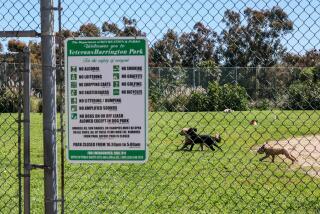Canine Behaviorists: Dog Trainers Who Use a Psychological Approach
- Share via
Dennis Fetko “learned how to walk hanging on to the side of a dog.”
So it was not surprising that he grew up to become a dog trainer. And he trained dogs, big dogs, the way trainers did at that time, with a lot of what he calls “chain jerking.”
Then he broke his back and was told that he could not work the way he did with 200-pound Newfoundlands anymore. So he went back to school and got a doctorate in human behavior and behavioral psychology and he learned that chain jerking “can be a very valid way to stop a dog’s actions, but when it’s the only way, you should be working with lawn mowers.”
Fetko, also known as Dr. Dog in San Diego, where he has a monthly call-in radio show on KSDO-AM, is a canine behaviorist. Canine behaviorists use the principals of psychology and behavior modification to correct undesired behavior in the common pooch.
Want Problems Solved
“Half the people in obedience training don’t want training, they want a problem solved,” Fetko said. An owner who takes his dog to a trainer because he digs, barks and chews will get a dog that “digs, barks and chews, but sits and heels,” he said.
The difference between a dog trainer and a dog behaviorist, Fetko said, is that “a trainer teaches a skill, a behaviorist teaches good behavior.” If a dog owner has a great Dane that pulls on the leash, “a trainer would teach it to heel, a behaviorist would teach it not to pull,” he said.
The profession is a new one, Fetko said: “It’s not in its infancy; it’s embryonic.”
To further their embryonic profession, 14 canine behaviorists met recently at the Newport Sheraton hotel to exchange views on paper-training, booby traps, food treats, systematic desensitization, separation anxiety and aggression. They shared professional secrets, such as the value of liverwurst, and talked about the ethics of euthanasia for dogs that bite humans.
Conference Held
The first annual Conference for Canine Behaviorists was organized by Sue Myles, owner of Companion Dogs by Sue Myles, a dog behavior therapy and obedience instruction operation in Newport Beach. Most of the behaviorists at the conference make their living by making house calls on dogs with behavior problems, Myles said.
Myles said she invited behaviorists she knew of from their reputations, and excluded people whom she knew to be “chain jerkers.”
They had doctorates, master’s and bachelor’s degrees in zoology, biology, anthropology, veterinary science, psychology and combinations thereof. None had a license or certificate to practice as a dog behaviorist, because no such certification exists, Myles said.
Fetko said people can and do call themselves behaviorists and charge $400 to $500 to teach dog owners chain jerking, and there is nothing to stop them. He said he doesn’t see any kind of certification in the next few years because “the animal field is so new, that (no one is qualified) to decide.”
Charges Vary
Myles said she charges $45 for an office visit and $65 if she goes to the client’s home. But Fetko, who declined to quote his fees, said other behaviorists can charge much more. If a dog has a behavior problem, he said, it can take four or five visits, which can run into hundreds of dollars. And all behaviorists charge more for treating aggression, Fetko said.
Consumers should look for some sort of training in behavior modification or psychology, Fetko said. There are a few universities beginning to offer degrees in animal behavior, but most of the behaviorists in the field have degrees in other fields, he said.
At the conference, the behaviorists discussed such common dog problems as house-soiling, barking, fear responses, aggression toward humans and destructive behavior in the owner’s absence.
Vickie Marx, a behaviorist who owns the West Coast Academy of Dog Training in Newport Beach, uses systematic desensitization to deal with separation anxiety. When an owner leaves for work, many times the dog thinks that he or she is never coming back, Marx said: “It’s like, ‘Mommy and daddy are leaving me.’ ”
Wrong Punishment
This produces an anxiety that the dog may relieve by barking, or chewing and destroying furniture, she said. Most dog owners punish the dog when they come home and discover the damage, but to show the dog the damage and hit him is pointless, Marx said, because “he will not make any association with that at all. The dog will just think he didn’t do a good enough job.”
Systematic desensitization involves putting the dog in an area by himself from time to time and gradually increasing the periods of solitude, which desensitizes the dog to being alone, Marx said.
Behaviorist Miriam Yarden, owner of Animal Behavior Guidance in Long Beach, said that owners could relieve some of the tension of separation anxiety by letting the dog feel their presence while they’re away. “Wear a T-shirt for a couple of days,” she suggested. “Don’t launder it and give it to the dog.” She said that owners who do this should not expect to get the shirt back.
“Putting on the radio is fine if you’re a radio listener yourself,” she said. Her major advice on this is to not make a big deal out of leaving and to get out of the house as quickly and quietly as possible.
Getting Attention
Yarden said dog owners who immediately punish a dog when they come home and find that he has eliminated on the living room rug may be “playing right into his paws.” Adult dogs who break house training may be doing it with the main intent of getting attention from their owners, she said.
“How better to get attention than going on the Persian carpet?” she said. What owners should do in a case like this is, among other things, spend time, “a good 10 to 15 minutes with the dog to the exclusion of others,” Yarden said.
Behaviorists disagreed on using the crate method to housebreak puppies. In the crate method, puppies are kept in a crate or a box when they are not being watched by their owners. The idea is “if you crate a puppy, it will not eliminate in its own nest,” Yarden said.
The dog can be kept in the crate for up to four hours and is given a specific time and place to eliminate, said Ron Berman, behaviorist and owner of Best Behavior in Manhattan Beach. The crate method takes advantage of a dog’s natural instincts, he said.
Den Animal
“It’s based on the fact that a dog is a den animal,” Berman said. A den is usually a small area, and, after they are a few weeks old, puppies learn to leave the den to eliminate, Berman said. Wild dogs seem to know that “littering the den would create a lot of bacteria and destroy the pack,” Berman said.
The crate is also small and is “natural for the dog,” Berman said. Owners tend to resist the crate because they think it is cruel, he said, “but once I explain the basics of it, they accept it.”
One of the behaviorists suggested telling dog owners to think of the crate as a crib for a baby.
“You can call it by 10 million baby names, but (to the owners) it’s still jail and ‘I won’t put my baby in jail,’ ” said Carole Schatz, owner of Best Friend Learning Center in San Diego. She said she doesn’t try to sway owners who are truly against the crate, and she doesn’t suggest it for people who work all day and leave the dog alone.
Worry About Claustrophobia
Yarden is against the crate method because she said it could cause internal problems for the dog if he is in the crate and can’t eliminate. “I worry about claustrophobia,” she said.
When a dog becomes aggressive and begins biting people, Deena Case, director of The Pet/People Relationship in Thousand Oaks, said she always discusses euthanasia as an option. “When a pit (pit bulldog) or a Rott (Rottweiler) or a shepherd becomes aggressive, it can be very serious,” she said. “We have to stress the ethical issues . . . and human beings come first.”
Myles also said that she has had to recommend euthanasia, but she has a method of dealing with what she called dominance-motivated aggression, where the dog shows aggression because he believes he is the dominant family member, the leader of the pack.
First, she removes the dog from the family for five to seven days and begins training it. The idea is for the dog to accept that human beings are dominant over him, she said.
Strokes on Head
Myles said she will stroke the dog on the head, something that dominant dogs do to others in the pack, give him a treat if he accepts that and withhold the treat if he shows aggression, such as growling. She keeps increasing the dominant behavior toward the dog and, when the dog goes back to the owner, he continues the training, she said.
“I have had increasing success with this,” Myles said.
More and more people are accepting canine behaviorists, just as they are accepting all kinds of psychology in general, Case said. “People used to say you have to be crazy to see a psychologist.”
And often, a behaviorist is the only option between keeping a dog and giving it away, Yarden said. When people love their dogs, she said, “it is very important that the dog fit into the family. This is a family member.”
More to Read
Sign up for Essential California
The most important California stories and recommendations in your inbox every morning.
You may occasionally receive promotional content from the Los Angeles Times.










